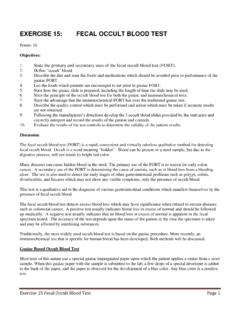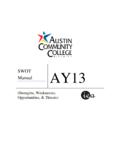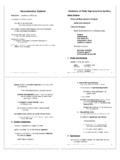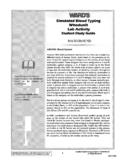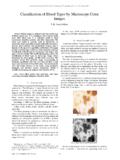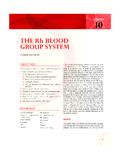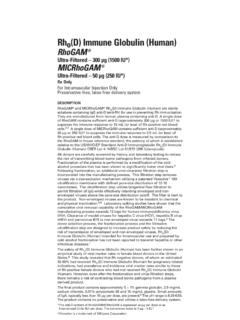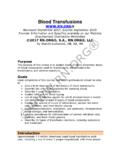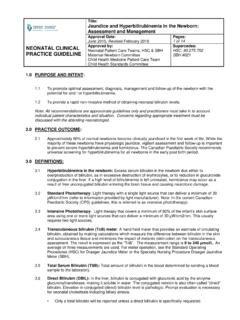Transcription of 3. ABO and Rh Typing - Austin Community College
1 EXERCISE 3 Laboratory Procedure ManualMLAB 2431 ABO and D Typing 21 Exercise 3 abo and D TypingTextbook:Blaney, Chapter 4 The ABO and H Blood Group SystemsSkills:20 why the ABO blood groups are the most significant of all blood group the 4 major ABO blood each blood group and state the ABO antigens present on the red blood each blood group and state the ABO antibodies expected to be present in the what is detected in performing the ABO forward what is detected in performing the ABO reverse a set of forward and/or reverse Typing reactions, interpret the the term ABO discrepancy . 6 common causes of ABO 6 methods which may be utilized to resolve ABO the action to be taken when an ABO discrepancy occurs and patient urgently needs a the significance of the D antigen as it relates to immunogenic.
2 The percentage of the population which is D positive and D the principle of the weak D the significance of a weak D positive person as a patient and as a blood 2 instances, when Typing for the D antigen, in which a D control must be and contrast the purpose of the D control for an AB pos person versus a D negative ABO Typing is the most important test performed in transfusion practice today. The single most common causeof transfusion-related fatalities is due to a patient being transfused with ABO incompatible blood. These reactionsoccur because individuals form potent, naturally occurring antibodies to ABO red cell antigens which they do notpossess. When transfused with ABO incompatible blood, an immediate antigen/antibody reaction occurs which,if not detected in time, may be terms D positive and D negative refer to the presence or absence of the D antigen on the red 85% of the general population have the D antigen on their red cells.
3 After A and B antigens, the Dantigen is the most important antigen in transfusion practice. The D antigen is very immunogenic. Individuals wholack the D antigen must be given D negative blood to prevent antibody antibodies are of the IgM class and react preferentially at 22EC (RT) or below. Incubation at warmtemperatures may cause a false negative reaction. Enhancement of weak reactions may be obtained by RTincubation or incubation at 4EC. EXERCISE 3 Laboratory Procedure ManualMLAB 2431 ABO and D Typing 22 There are three (3) types of tests which must be performed in order to determine an individual s ABO/D type: ABOforward, ABO reverse and D Forward TypingThis test is used to detect the presence or absence of A and/or B antigens on an individual's red blood cells.
4 An individual's ABO group is determined by testing the red blood cells with reagent anti-A and anti-B of the individual's red cells by the appropriate antisera signifies the presence of the antigen onthe red cell while no agglutination with the antisera signifies its testing of the red cells with Anti-A,B sera may be used for the detection of weak subgroups of Aor B. Because weak A or B subgroups have fewer antigens present on the red blood cells, very weak ornegative reactions may occur with anti-A or anti-B serum., but will give stronger or positive reactions withanti-A,B serum. The use of potent moncolonal antibodies has dramatically decreased the use of anti-A, the past Anti-A sera was obtained from group B individuals, anti-B serum was obtained from group Aindividuals, and anti-A,B serum was obtained from group O individuals.
5 Most facilities currently usemonoclonal source antibodies for blood Reverse TypingThis test is used to detect ABO antibodies in an individual's serum, and is used to confirm the ABOF orward Typing . There are structures present in nature on certain bacteria and pollens which are very similarto the A and B red cell antigens. Individuals will produce potent, naturally occurring antibodies directed1against the ABO antigens they lack. The patient's serum is mixed with reagent group A cells. Agglutinationindicates the presence of Anti-A in the patient's serum. Mixing the patient's serum with reagent group B cellssimilarly allows for the detection of anti-B in the patient's outcome of the serum Typing (Reverse Typing ) is compared with the outcome of the cell Typing (ForwardTyping) to ensure the accurate ABO determination.
6 Any discrepancy must be resolved before finalinterpretation of the blood group is A individuals lack the B antigen and their serum will agglutinate the reagent B cells due to theirnaturally occurring anti-B. Their serum will not agglutinate the reagent A cells since this antigen is presenton their own B individuals lack the A antigen and their serum will agglutinate A cells with their naturally occurringanti-A. Their serum will not agglutinate the reagent B O individuals lack both A and B antigens and their serum will agglutinate both the A and B reagentred cells. Group O individuals have 3 naturally occurring antibodies in their serum: anti-A, anti-B and anti-A, AB individuals have both A and B antigens on their red cells, and their serum will not agglutinate theA or B reagent red cells.
7 EXERCISE 3 Laboratory Procedure ManualMLAB 2431 ABO and D Typing 23 These two (2) tests, forward and reverse Typing , constitute the ABO Typing of an individual and are one ofthe check systems in routine Blood Banking. Remember that the forward Typing is indicative of theantigens present on an individual's red cells, while the reverse Typing is indicative of the antibodies presentin the individual's serum or plasma. The forward type must correlate with the reverse type and anydiscrepancy must be ABO discrepancy is a situation in which reactions obtained in the forward type DO NOT match orcorrelate with reactions obtained in the revers type.
8 For example, no agglutination when testing a patient withanti-A and anti-B indicates that a patient is group O. The expectation then is that both the A and B reagentcells will be agglutinated by the patient s serum. If negative reactions occur with one or both reagent red cellsthen an ABO discrepancy has occurred. No blood may be issued for transfusion until the ABO discrepancyhas been resolved. If the need is urgent the technician may need to consult with the patient s physician andthe pathologist. The type of discrepancy involved will determine how the situation is to be for an ABO discrepancies:221! subgroup of A (A or AB) with anti-A - patient forward types as A but agglutinates !
9 Strong cold autoagglutinins present - A, B or AB patients will agglutinate reagent rbc s! patient may be an infant, elderly or immunodeficient resulting in decreased antibody levels - lack ofexpected agglutination reactions of reverse cells.! rouleaux - unexpected positive reactions in reverse cells.! unexpected antibodies in the serum -unexpected positive reactions in reverse cells.! patient s red blood cells heavily coated with protein - unexpected positive reactions in forward of ABO the forward and reverse - this should always be the first course of patient is group A or AB, but reverse types as an O (false positive), test the RBCs with anti-A. If the2222patient is A or AB test their serum against A cells.
10 Lack of agglutination of the A cells indicates that1the patient has the reverse type gives false negative reactions allow the serum and cells to incubate at RT for 5-10minutes. Respin. False negative reactions are usually due to low levels of antibody being present. Theincubation period allows time for additional antibody positive reactions in the reverse may be due to strong cold agglutinins additional testing must beperformed cold agglutinin titer, prewarmed technique to resolve this positive results in the reverse may be due to rouleaux. Examine tubes microscopically to saline replacement technique (spin tubes down, remove serum, add saline, respin and read).


